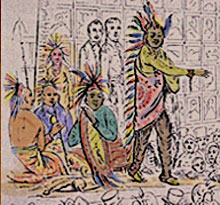The Frontier West ExhibitThe Lost Museum Archive

Wagon trains began carrying emigrants into the American West during the 1830s, and by 1869, when the first transcontinental railroad was completed, as many as 350,000 Americans had moved toward the Pacific. This movement of people to a variety of frontier destinations from Texas and Kansas to California and Oregon, created conflict over the spread of slavery and wholesale displacement of the native tribes whose land was now sought by new settlers. The promise of individual land ownership embodied in the 1862 Homestead Act was often subverted by land speculators. Despite such harsh realities, the settling of the frontier also engendered a romantic vision. Those who remained behind eagerly consumed artifacts and accounts of the westward journeys of others. The American Museum catered to this fascination with exhibits ranging from the foolish (Colonel Fremont’s fictional “wooly horse”) to the supposedly anthropological (the “Ioway Indians”). The writer and promoter George Catlin also catered to this interest in all things western with ethnographic paintings and lectures about the fast disappearing Plains Indian tribes.